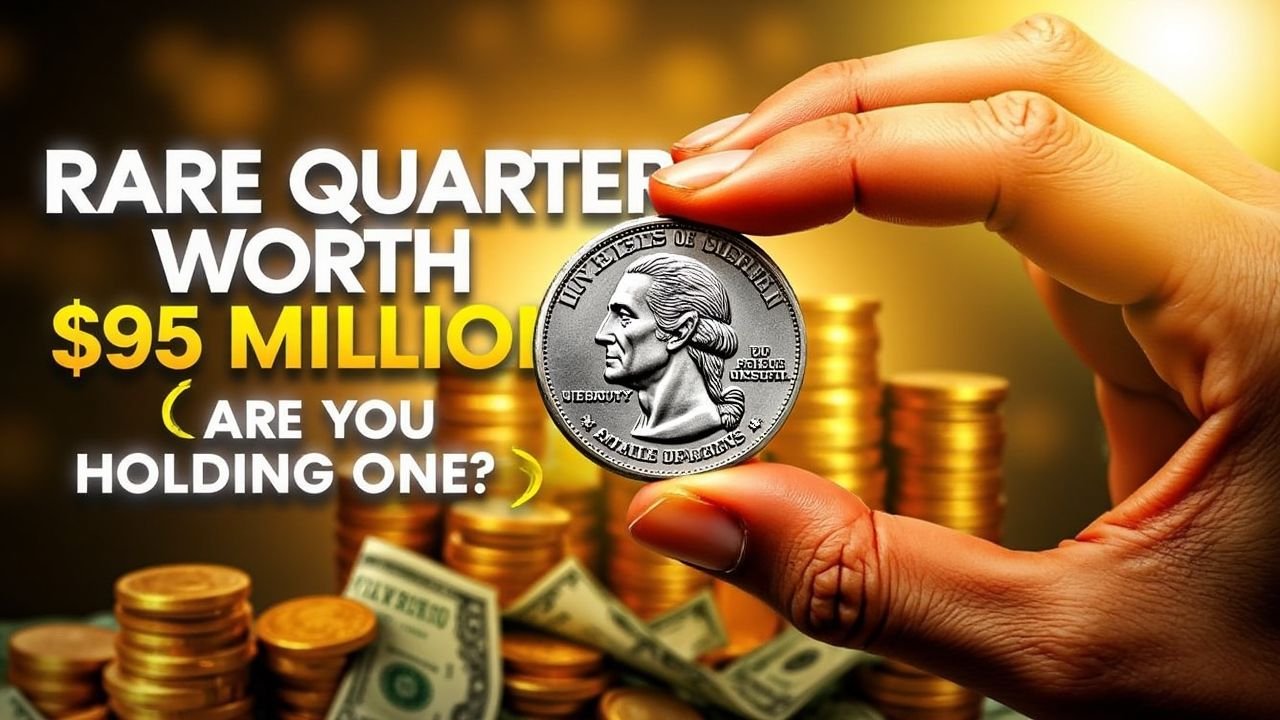Some rare quarter coins leave both collectors and investors shouting about some incredible figures in the numismatic valuation.
The smallest and least valuable pieces of history with a face value of 25 cents can reach prices of as much as $95 million, representing some of the greatest currency artifacts out there.
To prove their worth, a person must first learn that these quarters in question are actually very special. They are all quite valuable due to reasons such as mintage errors, historical events, and extraordinary conservation.
Exhibit some of these rare features, dive into some stories behind the most valuable quarters of America, take lessons on how these quarters earn those astronomical prices, and lead guides for those wanting to discover would-be hidden treasures in plain sight.
Most Valuable Quarters in History
The numismatic world was shocked when the private auction of the 1796 Draped Bust Quarter was sold for close to $95 million, breaking all records.
This coin, which was one of the first quarters ever made by the United States Mint, shows Lady Liberty with flowing hair on the obverse and an eagle on the reverse.
But what makes this particular specimen so expensive, aside from its age, is its phenomenal state of preservation. Graded MS-67 by the Professional Coin Grading Service (PCGS), it features nearly perfect surfaces and exceptional luster, making it the finest known specimen of America’s first quarter design.
The 1932-D Washington Quarter is another milestone in American numismatics. Only 436,800 coins scored at this Denver mint during the Great Depression, and that has made it one of the most well-known coins in the annals of collecting.
In perfect condition, such quarters are touted to fetch hundreds of thousands of dollars. One particular specimen, graded MS-66, sold for $143,750 at auction, illustrating how parsimony in preservation invariably yields great value.
The 1901-S Barber Quarter is one of the most elusive coins ever issued in American history. With a mintage of just 72,664, the vast majority went into circulation and became worn, making finding an uncirculated example extraordinarily rare.
A pristine MS-67 example sold for more than $550,000, making it one of the most valuable quarters ever sold at public auction. Even substantially worn examples can sell for over $5,000, proving the premium placed upon this key date.

Mistakes Provide Fortune Mint Errors
One of the best-known modern mint errors is that for the 2004-D Wisconsin State Quarter with an extra leaf. The mint design, which depicts a state quarter and has a leaf on an ear of corn, instantly became rare when producing an additional leaf during the final mint striking for this coin.
Though technically errors, these coins can be bought for $300 to $1,500 based on condition; a healthy margin above face value to be sure. The extra leaf varieties are still prowling around the houses of clientele after modern-day rarities.
Double die errors occur when a die which is then used to strike a coin receives its impressions multiple times, slightly offset from one another, which causes the doubling on some of the design elements.
Noticeable doubling is exhibited on the date and motto of the 1950-S Washington Quarter Uncirculated, Doubled Die Obverse.
Although lesser-known when compared to some double die cents, an uncirculated version of these quarters can go as high as $500 to $2,000 apiece, drawing specialists on error coinage who appreciate such manufacturing anomalies.
A coin blank is not held centered as it’s being struck, and that causes an off-center strike. Quarters off-center, showing part design and blank areas, mostly struck 20% to as much as 50% missing part of the design give striking visual error, which collectors chase after.
For the most part, dramatic errors will range in price from $100 to several thousands based on the percentage the coin is off-center and whether or not the date is visible. The most extreme will, of course, demand the highest premiums.
Factors That Determine Value
Rarity surely must hold forth as the foremost determinant of the value of a particular quarter. Coins with low mintage figures, or such coins that merely survive in very few examples, create natural scarcities that propel prices upward in the competitive collector market.
Key dates like the 1932-D and 1932-S Washington Quarters command significant premiums due to limited production runs during the first year of the Washington Quarter series. Even in circulated condition, these coins will sell for hundreds of dollars.
The condition is weighed according to professional consensus on a 70-point Sheldon Scale. Major value impacts will be seen; an MS-65 Mint State condition coin may be worth ten times more than coin grading MS-60, exemplifying the premium placed on high conservation.
With the rare dates, every single point of difference in grading could multiply the coin’s value by several times. The difference between an AU-58 Almost Uncirculated and an MS-63 1932-D Quarter could mean thousands of dollars in market value.
Another dimension of value for certain quarters is the importance of history. While the 1776-1976 Bicentennial Quarter is a common circulating coin, it nonetheless stands for the occasion of America’s 200th anniversary, thus having cultural significance beside its economic value.
Coins that represent watershed moments for America or technological innovations in minting often attract a following of historians and collectors who appreciate the history represented by a little metal disk.
Factor of Silver Content: Intrinsic Value
Silver quarters minted before 1965 are composed of 90% silver and 10% copper and have intrinsic value in addition to their numismatic value. The silver content of such quarters is estimated to be 0.18 troy ounces.
In inflationary times, these coins can trade for multiples of their face value on account of their metal content. At the silver price of $25 per ounce, common date silver quarters of the 1940s and 1950s might command anywhere from $5 to $7 each.
Interest in the last silver quarters of 1964 was created when the transition to copper-nickel clad composition took effect. These large mintages were hoarded, anticipating the change in composition.
In what arguably is the rarest type of error coin, a few 1965 quarters were struck by mistake from silver blanks, instead of the new copper-nickel clad blanks, and sell for thousands when authenticated by major grading services.

Rare Quarters Collecting Strategies
Collecting a set of rare and valuable quarters is a combination of knowledge, patience, and strategic buying. It is wise for beginners to concentrate on one series, such as Standing Liberty or Washington Quarters, cultivating expertise in that area.
Completing what is called date and mintmark sets in combination within their chosen series has attracted many collectors. This means obtaining one of each year-mint combination. Some structure gets added to the collection, yet the collector can spend more time upgrading the quality of the pieces within this structure.
Scouting for Hidden Treasure Quarters
Although the odds against finding a million-dollar quarter in your pocket change are exceedingly slim, such coins can occasionally still be found in circulation. For example, 1932-D and 1932-S Washington Quarters worth hundreds in even very worn condition could still be discovered by vigilantly searching.
Over the years, silver quarters minted before 1965 have been discovered from time to time in circulation. One can identify these quarters by their sound when dropped on a hard surface, and also by their shiny ragged edges compared with modern coins’ copper-nickel sandwiches.
However, a better way of finding a valuable quarter is through rolls of banknotes. You can buy a $10 roll from a bank, and now you’re looking at 40 quarters at once instead of just a couple. That’s a much better shot at finding something awesome without having to pay more than face value.
Rather, many collectors would befriend a bank teller and then ask such tellers to keep a few of the older coins alone. Such tellers would also usually set aside wrapped rolls contains coins which mostly get deposited by customers who did not know that these coins carry lores in numismatics.
Metal detecting sometimes turns up valuable quarters lost many decades ago around historic sites, old homes, or former fairgrounds. Although such coins are often quite tarnished from environmental damage, their rarity may still confer considerable value.
The thrill of the hunt keeps many collectors involved with it — even though slim, the remotest possibility of making a valuable discovery through patient and persistent searching of circulating coinage or metal-detecting sites inspires them.
The Future of Rare Quarter Values
The rare coin market seems poised for continued appreciation of genuinely rare coins in excellent conditions. As well-heeled collectors vie for trophy coins of superlative quality, prices for the finest known examples of rare dates continue reaching unprecedented heights garnered by major auctions.
The artificially limited supply of high-grade early quarters ensures their status as valuable collectibles, with each passing year diminishing the likelihood that any unworn examples will survive unscathed as coins get lost, damaged, or are permanently laid away into long-term collections.
Generational interest shifts have seemingly led to a growing interest in the hobby among young collectors through programs such as the 50 State Quarters Program (1999-2008), which introduced millions of Americans to coin collecting and created new modern rarities.
With vast amounts of information now available online, knowledge concerning rare coins has become democratized, enabling a greater audience to identify potentially valuable specimens that they could save rather than spending them at face value.
Like with any market for tangible assets, economic conditions do affect the values of rare coins. In times of inflation or economic uncertainty, tangible assets like rare coins are likely to see a spike in demand as wealth preservation tools.
FAQS:
Are these rare quarter coins really worth $95 million?
The $95 million refers to the estimated overall value of several ultra-rare quarters–some varieties of the 1976 Bicentennial quarter and quarters with minting errors that command the admiration of collectors.
Which quarter is worth the most?
One of the most valuable of these is the 1976 Bicentennial “Liberty Drummer” Quarter, which in rare instances has achieved prices in excess of $5 million at private auction, owing to the aforementioned condition and rarity.

